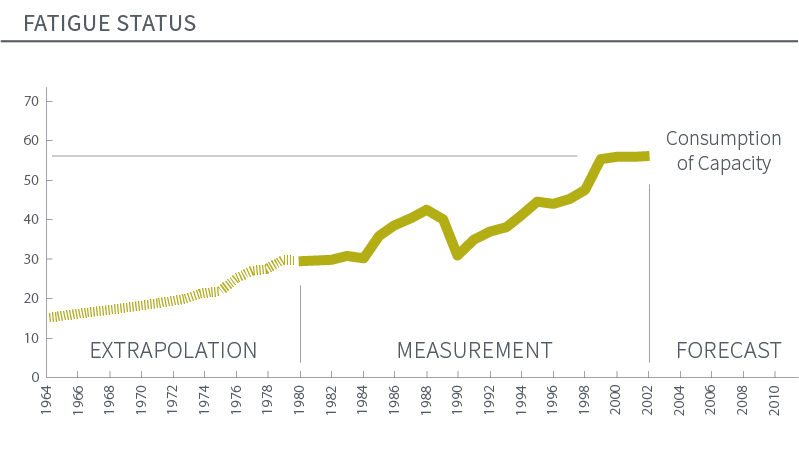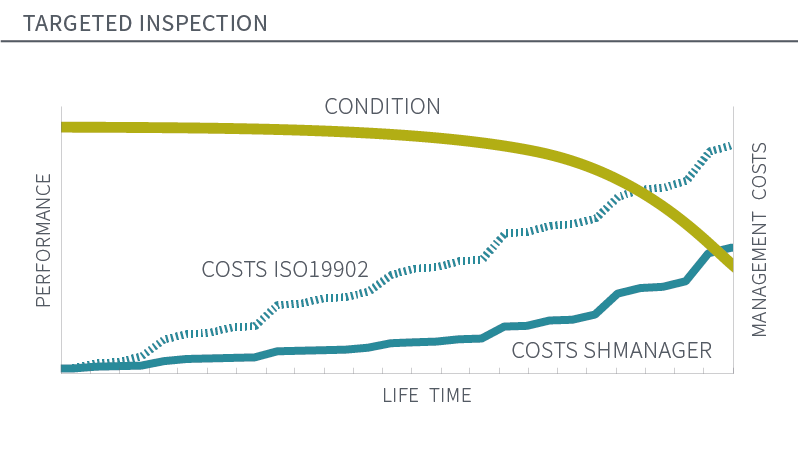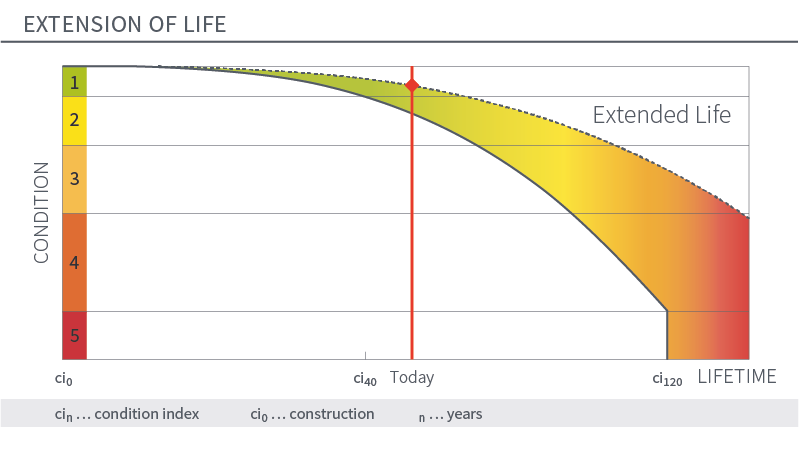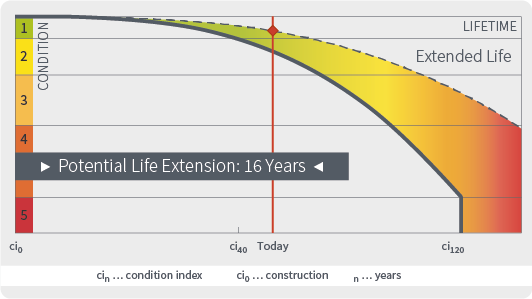Asset Management
The goal of asset management is to maximize the effectiveness of an asset while optimizing the efficiency of operating expenses. This requires a focus on the identification of potential risks during the different phases of the asset’s life cycle. Successful early identification of potential risks relating to the state or health of the asset can not only lead to a significant reduction in operating costs but also, in the end, serve to extend the service life of the structure.
WIMOS is a proven asset management system with a user-friendly web interface which reduces uncertainties concerning the integrity of offshore structures. This system uses data gathered from monitoring sensors on the structure to create reports and alarms to support operations decision-making for the management of the structure – online and in realtime. It is then possible to perform a detailed analysis based on the data collected and modeling in order to achieve effective life cycle engineering.




Structural Health Monitoring
Data Specific Tool Box (online & Realtime)
The first step in effective and efficient structural health management is gathering data regarding the actual behavior of the structure. We can design, supply and install a measurement system consisting of high-quality, robust sensors suitable for harsh offshore conditions or we can integrate previously installed existing sensors into the WIMOS data acquisition system. The main advantage of our measurement systems is that it is designed for easily accessible sensor locations above the water level, thus minimizing maintenance costs later.
Although there are a number of different sensors currently available for monitoring different aspects of structural behavior, the WIMOS system is based on data from a limited number of sensors, such as strain gauges, inclinometers and accelerometers. The accelerometers we install are very robust and have an extremely high dynamic range, making it central in the determination of structure dynamic behavior. The structure dynamic behavior is, in turn, highly correlated to the structure’s load bearing capacity and its integrity.
High-quality and cost-effective data capture is just the beginning of process. WIMOS measurement campaigns are designed for integration in the existing communication interfaces and SCADA connections of the offshore wind farm. WIMOS supports the safety standards relevant to the operation of offshore wind farms, as well as SCADA Protocols. Furthermore, we use the Reference Designation System for Power Plants (RDS-PP) in the design and implementation of all our projects and the WIMOS documentation meets and exceeds the high standards of the offshore industry.
The WIMOS Web GUI is the heart of this monitoring system. Regardless of the brand of measurement hardware used to capture the structural data, the WIMOS Web GUI both processes and presents the monitoring data in a web layout which can be customized to meet project and project stakeholder needs. The WIMOSuser interface enables you to view measurement data from various sensors and monitor data availability – online and in realtime.
A system of alarms is configured for the early detection of structural changes, unusual structural behavior, load exceedance and the identification of stress-relevant operating conditions. A comprehensive log book and ticket system for alarms and anomalies contributes to the WIMOS excellent technical documentation system.
Automatic data evaluation routines provide data analysis results to support operations decision-making. Depending on your focus in the project, you can use WIMOS to optimize maintenance intervals, compare the behavior of individual WTGs or to document the current state of the structure.

Further features of the WIMOS Web GUI include:
- Web access
- Automatic adaption to different screen sizes (responsive design)
- Different access levels and dashboards for different user groups, such as managers, operations teams, structural engineers, etc.
Structural Health Management
Structure Specific Tool Box
Condition Management
Asset Management Support
– Investigation – Condition based Inspection – Risk Monitoring – Maintenance –
Objectives of the Model Based Structural Assessment
The advanced model based structural assessment aims at the interpretation of the Monitoring data and the assessment of the structural condition with regard to structural safety and durability.
The offered services will provide following information to the employer which will be provided in form of (annual) reports:
1. As Built Performance of the structures in comparison with the design assumptions. Any deviation can be determined by the dynamic KPIs.
2. Condition Changes, caused by corrosion, overloading, scour or problems with grout connections, of the built structures over time will be directly reflected by the dynamic response and changes of the dynamic KPIs.
3. Location of Damages will be detected by model updating of the dynamic model. This supports further assessment of damages and the planning or repair or improvement.
4. Detection and Quantification of Scour is also a result of the data analysis. Scour will also be reflected by the dynamic response.
5. Analysis of the Real Ultimate Load will be part of the data analysis, model updating and annual reports.
6. Calculation of Fatigue and Remaining Fatigue Life will be done from the analysis of the monitoring data The derived fatigue life including lower and upper boundary limits will be submitted with the annual reports. The results of the analysis may allow for extension of life.

Analysis of the As-Built-Performance by System Identification
Therefor a dynamic FE-Model representing the desired performance will be created. Dynamic models for the simulation of the behaviour of real structures have to represent a realistic image of the actual load-bearing capacity in order to provide an accurate result.
Materials, flexural and spring stiffness as well as masses and the moment of inertia of the individual elements are particularly important for the selection of individual parameters. The aim of modelling the structure is to lose as little information as possible despite far-reaching simplification of the complex building for the input of the structure. This is decisive for a realistic calculation of the dynamic parameters like eigen- frequencies and mode shapes. Mass distribution of the structure and actual boundary conditions are decisive points when deciding the magnitude of the calculated eigenfrequencies. The assumptions regarding the characteristics of the foundation structure and soil are of extreme importance in the development of the dynamic model.

The model obtained is a “target behaviour” model that must be compared with the “actual behaviour” of the structure obtained via measurements.
A verification of the dynamic structure model is necessary. For this purpose the monitoring data (initial measurements and permanent monitoring) if the offshore structure under working conditions will be used. The indicators frequency, eigenform and damping are examined for several eigen- frequencies. The results will be used to derive the system identification.

There will be deviations between the theoretical and measured dynamic behaviour of the turbines and foundations. The analysis results will be used for the updating of the FE-Model from the design phase. In this way the differences can be interpreted and the real behaviour of the structures can be modelled.
The model obtained is the “real” as build behaviour and can be compared to the target behaviour for design and construction quality proof.
Ultimate Load Analysis
The updated FE-Model allows for ultimate load analysis. The maximum load the system can tolerate is determined. This will be repeated for various load cases and failure modes. The result is the structural safety of the as built structure.
Sensitivity Analysis to Identify Hotspots
On the updated FE- model, sensitivity analyses can be performed to identify any existing hotspots. The sensitivity analyses also determine the measurement parameters necessary for the structure monitoring. Furthermore, it is also possible to estimate structure redundancy against failure of single components.
Periodic Condition Assessment by Model Update
As described above, a model update has to be done initially to get the structure as built properties. Whenever the permanent monitoring systems shows changes in the structural behaviour, the model update can be repeated with actual data.
This gives the actual structure properties. Comparison to the as built structure properties results, in structure changes, degradation, damage etc.
This approach will be applied to:
– Scour
– Corrosion
– Marine Growth
– Possible structural change due to wave slamming or vessel impact
– Or other questions related to the structure load bearing capacity
Fatigue Life Determination

The principle of fatigue-life calculation is the counting of relevant stress cycles in critical locations of the monopole and the transition piece. This can either be done by the application of strain gauges or by the calculation of stress-cycles from the dynamic analysis. This is done by the dynamic parameter vibration intensity.
For both methods the counting of the load cycles (rainflow counting) and the modelling of the stress distribution by an FE-model is required as the sensors cannot be applied to the most critical locations. The advantage of the monitoring of the dynamic behaviour with accelerometers is the much longer lifetime of the sensors compared to the strain gauges and the better stability of the sensors. Strain gauges always show a long-term drift of the measurement signal which influences the measurement results.
Quantification of Life Extension
The monitoring data set will be analysed in periodic intervals. A respective report will be issued. The most important results about the behaviour and eventual changes over time will be highlighted.
A prognosis on the actual consumed life span will be given over a period of three-times the monitoring period. This report contains the actual expertise recommendations on eventual necessary activities as well as information about the behaviour in comparison to the plan. Life Cycle computations.
The proposed procedure produces information which allows the determination of a period for safe operation of the structure. Through this procedure in general additional time of operation is gained and assets can be economically optimized.

